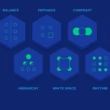Color theory is a set of guidelines that helps us understand how colors work together. It explains how colors are created, how they interact with each other, and how they affect our emotions and perceptions. It is used in art, design, fashion, marketing, and even psychology to create visually appealing and effective combinations.
Understanding the Color Wheel
The color wheel is a circular diagram that shows the relationships between different colors. It is divided into three main categories:
Primary Colors
These are the three basic colors that cannot be made by mixing other colors. They are:
- Red
- Blue
- Yellow
All other colors come from mixing these primary colors in different ways.
Secondary Colors
When you mix two primary colors, you get secondary colors. These are:
- Green (made by mixing blue and yellow)
- Orange (made by mixing red and yellow)
- Purple (made by mixing red and blue)
Tertiary Colors
When you mix a primary color with a secondary color next to it on the color wheel, you get a tertiary color. Examples include:
- Red-Orange (made by mixing red and orange)
- Yellow-Green (made by mixing yellow and green)
- Blue-Purple (made by mixing blue and purple)
Color Harmonies: How Colors Work Together
Some colors look better together than others. Color harmonies are combinations that create a pleasing effect. Here are some common types:
Complementary Colors
These are colors that are opposite each other on the color wheel. When placed together, they create a strong contrast. Examples include:
- Red and Green
- Blue and Orange
- Yellow and Purple
Analogous Colors
These are colors that sit next to each other on the color wheel. They create a calm and harmonious look. Examples include:
- Blue, Blue-Green, and Green
- Red, Red-Orange, and Orange
Triadic Colors
This harmony uses three colors that are evenly spaced around the color wheel, forming a triangle. It creates a vibrant and balanced look. Examples include:
- Red, Yellow, and Blue
- Orange, Green, and Purple
Monochromatic Colors
This scheme uses different shades, tints, and tones of a single color. It creates a clean and elegant appearance. For example, using different shades of blue from light to dark in a design.
Warm and Cool Colors
Colors are also divided into two main groups:
- Warm Colors (such as red, orange, and yellow) make things feel energetic, exciting, and cozy. They are often used in restaurants and advertisements to attract attention.
- Cool Colors (such as blue, green, and purple) create a calm and relaxing effect. They are commonly used in hospitals, spas, and offices to create a peaceful atmosphere.
How Colors Affect Emotions
Colors can influence how we feel and react. This is called color psychology. Some examples include:
- Red: Represents passion, love, and energy. It is used in sales and marketing to grab attention.
- Blue: Symbolizes trust, calmness, and reliability. It is often used in banks and technology brands.
- Green: Represents nature, health, and growth. It is used by eco-friendly and organic brands.
- Yellow: Creates happiness, warmth, and positivity. It is often used in children’s products.
- Purple: Represents creativity, luxury, and mystery. It is used in beauty and fashion industries.
Conclusion
Color theory helps us understand how colors work together and affect our emotions. It is essential in design, branding, and everyday life. Whether you are an artist, designer, or someone choosing colors for your home, understanding color theory can help you make better choices. By using the color wheel, color harmonies, and color psychology, you can create visually appealing and meaningful combinations.
Would you like to explore specific areas of color theory in more detail?










